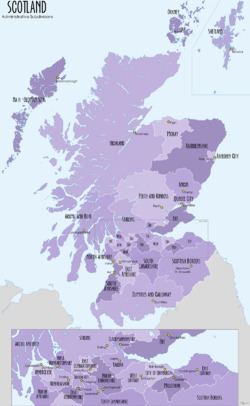Category Administrative unit Number 32 Councils | Government Council government | |
 | ||
Subdivisions of scotland
For local government purposes, Scotland is divided into 32 areas designated as "council areas", which are all governed by unitary authorities designated as "councils". They have the option under the Local Government (Gaelic Names) (Scotland) Act 1997 of being known (but not re-designated) as a "comhairle" when opting for a Gaelic name; only Comhairle Nan Eilean Siar (Council of the Western Isles) has chosen this option, whereas the Highland Council (Comhairle na Gaidhealtachd) has adopted its Gaelic form alongside its English equivalent informally.
Contents
- Subdivisions of scotland
- History of the subdivisions of Scotland
- Council areas
- Other subdivisions
- Police and fire services
- Historically
- Electoral and valuation
- Health
- Transport
- Eurostat NUTS
- Land registration
- Sheriffdoms
- Civil parishes
- Communities
- References
The council areas have been in existence since 1 April 1996, under the provisions of the Local Government etc. (Scotland) Act 1994.
Historically, Scotland has been divided into 34 counties or shires. Although these no longer have any administrative function, they are still used to some extent in Scotland for cultural and geographical purposes.
History of the subdivisions of Scotland
Traditionally burghs have been the key unit of the local government of Scotland, being highly autonomous entities, with rights to representation in the old Parliament of Scotland. Even after the Acts of Union 1707, burghs continued to be the principal subdivision. Until 1889 administration was on a burgh and parish basis.
The years following 1889 saw the introduction of a hierarchy of local government administration comprising counties, counties of cities, large burghs and small burghs.
With effect from 16 May 1975 and until 31 March 1996 the local government divisions of Scotland consisted of an upper tier of regions each containing a lower tier of districts except for the single-tier island council areas.
Council areas
Source: 2011 Census for Scotland
Other subdivisions
Scotland has several other administrative divisions, some of which are handled by joint boards of the councils.
Police and fire services
The Police and Fire Reform (Scotland) Act 2012 resulted in the merger of local police and fire services on 1 April 2013 to form the Police Service of Scotland (Scottish Gaelic: Seirbheis Phoilis na h-Alba) and the Scottish Fire and Rescue Service (SFRS, Scottish Gaelic: Seirbheis Smàlaidh agus Teasairginn na h-Alba).
Historically
(Pre 1975)
Policing was the responsibility of the Cities and Burghs of Scotland. (see List of burghs in Scotland)
(1975 - 2013)
Police and fire service areas date from the era (1975 to 1996) of regions and districts and island council areas.
Electoral and valuation
There are several joint boards for electoral registration and the purposes of property valuation for assessing council tax and rates.
Health
See also NHS Scotland
Until 1 April 2014 the towns of Cambuslang and Rutherglen were in the Greater Glasgow and Clyde health board area despite being located in South Lanarkshire. They are now part of NHS Lanarkshire.
Transport
The Scottish Government has created seven "Regional Transport Partnerships", for establishing transport policy in the regions. They broadly follow council area groupings.
Eurostat NUTS
In the Eurostat Nomenclature of Territorial Units for Statistics (NUTS), Scotland is a level-1 NUTS region, coded "UKM", which is subdivided as follows:
Land registration
The current land registration system in Scotland divides Scotland into 33 counties, each coming into effect on various dates between 1981 and 2003. These areas in most cases resemble those of the pre-1975 administrative counties with Glasgow being the only current city to form a registration county.
Sheriffdoms
Sheriffdoms are judicial areas. Since 1 January 1975, these have been six in number:
Civil parishes
Scotland is divided into 871 civil parishes which often resemble same-named but legally different ecclesiastical parishes. Although they have had no administrative function since 1930, they still exist and are still used for statistical purposes such as the census. Many former civil parish areas also continue to form current registration districts. It should be noted that many boundary changes have occurred over the years and that an area currently derived from an old parish might no longer contain a place previously within that parish. Similarly, county boundaries (as still used for land registration) have also changed over the years such that a parish mentioned historically (generally before the 1860s) as being in one county (or sometimes two due to straddling a border) might now be in a neighbouring county and consequentially in a different succeeding council area.
Communities
The base level of sub-division in Scotland is that of communities, which may elect community councils (CCs). The main role of the CCs is to channel local opinion to larger local-government bodies. Otherwise, they have very limited powers. There are around 1,200 communities in Scotland. Not all communities have councils; some have joint councils.
Scottish communities are the nearest equivalent to civil parishes in England.
